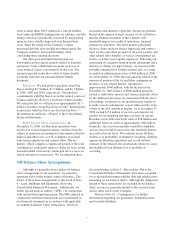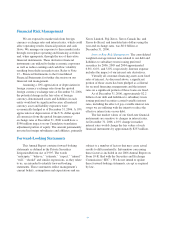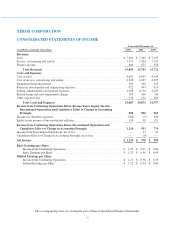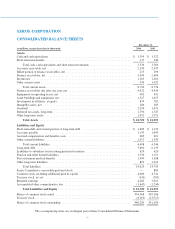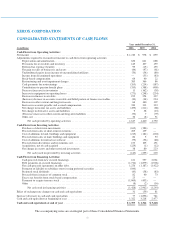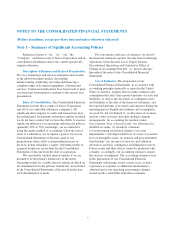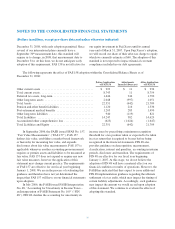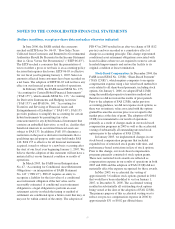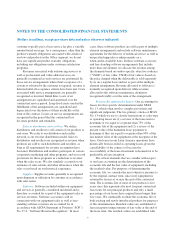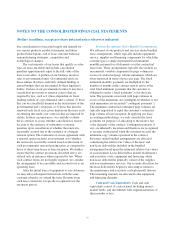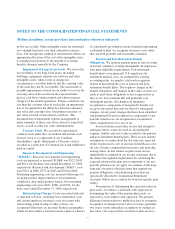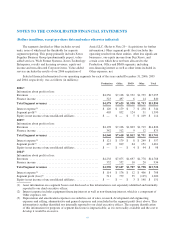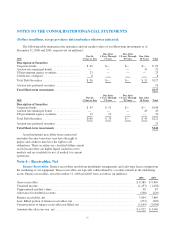Xerox 2006 Annual Report Download - page 58
Download and view the complete annual report
Please find page 58 of the 2006 Xerox annual report below. You can navigate through the pages in the report by either clicking on the pages listed below, or by using the keyword search tool below to find specific information within the annual report.
NOTES TO THE CONSOLIDATED FINANCIAL STATEMENTS
(Dollars in millions, except per-share data and unless otherwise indicated)
December 31, 2008, with early adoption permitted. Since
several of our international plans currently have a
September 30th measurement date, this standard will
require us to change, in 2008, that measurement date to
December 31st. At this time, we do not anticipate early
adoption of this requirement. FAS 158 is not effective for
our equity investment in Fuji Xerox until its annual
year-end of March 31, 2007. Upon Fuji Xerox’s adoption,
we will record our share of their after-tax charge to equity
which we currently estimate at $60. The adoption of this
standard is not expected to impact financial covenant
compliance included in our debt agreements.
The following represents the effect of FAS 158 adoption within the Consolidated Balance Sheets as of
December 31, 2006:
Before Application
of FAS 158
Adjustments
Increase/(Decrease)
After Application
of FAS 158
Other current assets ................................... $ 923 $ 11 $ 934
Total current assets .................................... 8,743 11 8,754
Deferred tax assets, long-term ........................... 1,446 344 1,790
Other long-term assets ................................. 2,048 (997) 1,051
Total Assets ......................................... 22,351 (642) 21,709
Pension and other benefit liabilities ....................... 1,120 216 1,336
Post-retirement medical benefits ......................... 1,205 285 1,490
Other long-term liabilities .............................. 940 (119) 821
Total Liabilities ...................................... 14,247 382 14,629
Accumulated other comprehensive loss .................... (623) (1,024) (1,647)
Total Liabilities and Equity ............................. 22,351 (642) 21,709
In September 2006, the FASB issued SFAS No. 157,
“Fair Value Measurements” (“FAS 157”). FAS 157
defines fair value, establishes a market-based framework
or hierarchy for measuring fair value, and expands
disclosures about fair value measurements. FAS 157 is
applicable whenever another accounting pronouncement
requires or permits assets and liabilities to be measured at
fair value. FAS 157 does not expand or require any new
fair value measures, however the application of this
statement may change current practice. The requirements
of FAS 157 are effective for our fiscal year beginning
January 1, 2008. We are in the process of evaluating this
guidance and therefore have not yet determined the
impact that FAS 157 will have on our financial statements
upon adoption.
In July 2006, the FASB issued FASB Interpretation
No. 48, “Accounting for Uncertainty in Income Taxes –
an Interpretation of FASB Statement No. 109” (“FIN
48”). FIN 48 clarifies the accounting for uncertainty in
income taxes by prescribing a minimum recognition
threshold for a tax position taken or expected to be taken
in a tax return that is required to be met before being
recognized in the financial statements. FIN 48 also
provides guidance on derecognition, measurement,
classification, interest and penalties, accounting in interim
periods, disclosure and transition. The requirements of
FIN 48 are effective for our fiscal year beginning
January 1, 2007. At this stage, we do not believe the
adoption of FIN 48 will have a material effect on our
financial condition or results of operations. However, the
FASB has indicated that they expect to issue additional
FIN 48 implementation guidance regarding the ultimate
settlement of a tax audit, which may impact the timing of
certain liability adjustments. Accordingly, such guidance
may impact the amount we would record upon adoption
of this statement. We continue to evaluate the effects of
adopting this standard.
56




